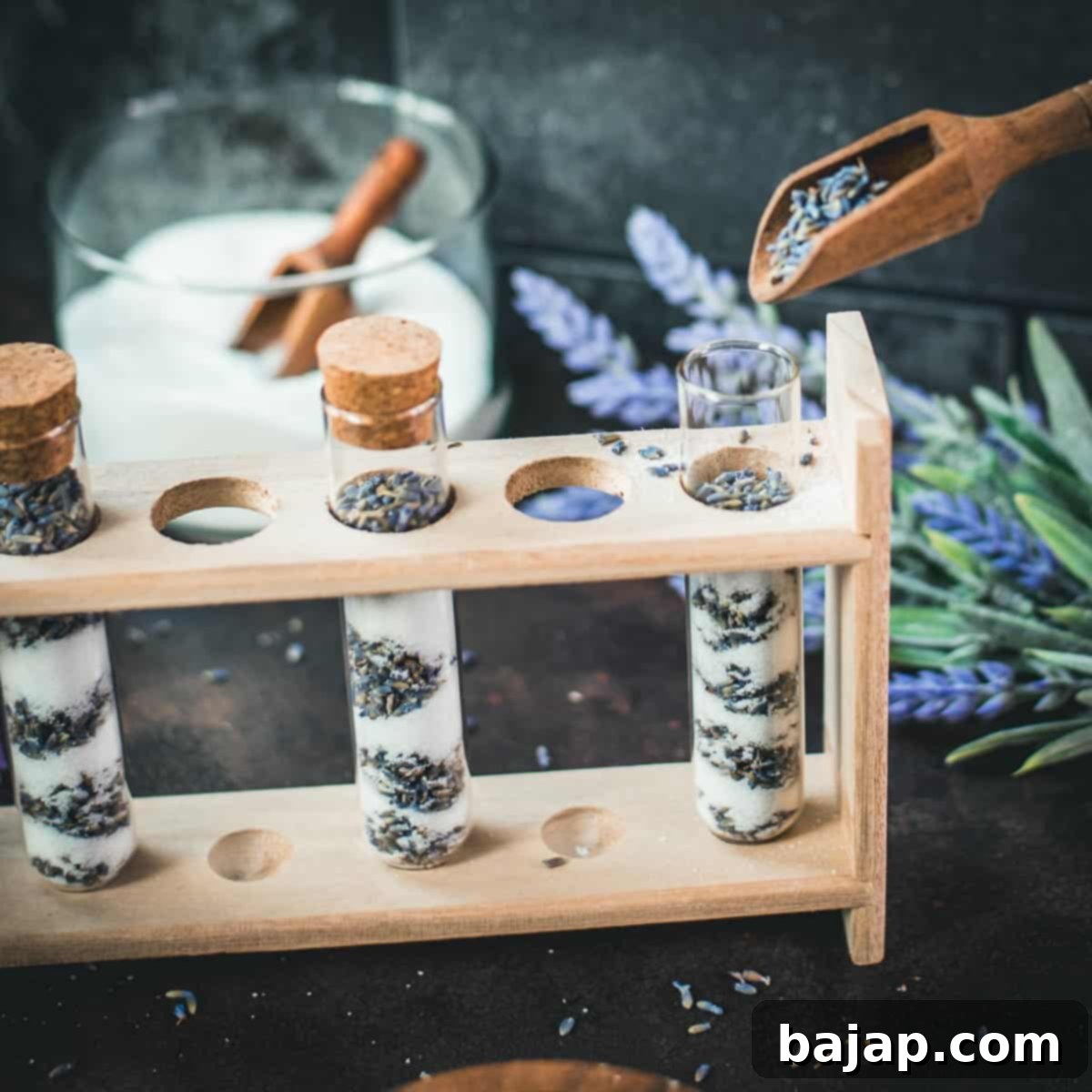Homemade Lavender Sugar: An Easy Recipe for Floral Sweetness & Edible Gifts
Transform your everyday baking and beverages into something truly special with this incredible recipe for **Homemade Lavender Sugar**! Imagine your kitchen filled with the delicate, soothing aroma of lavender, culminating in a beautiful, aromatic sugar that’s as versatile as it is elegant. This easy-to-make infused sugar is not just a delightful ingredient; it’s a sensory experience, adding a unique floral note to your favorite treats and making for the most charming homemade gifts. Get ready to elevate your culinary creations and infuse a touch of botanical magic into your home.
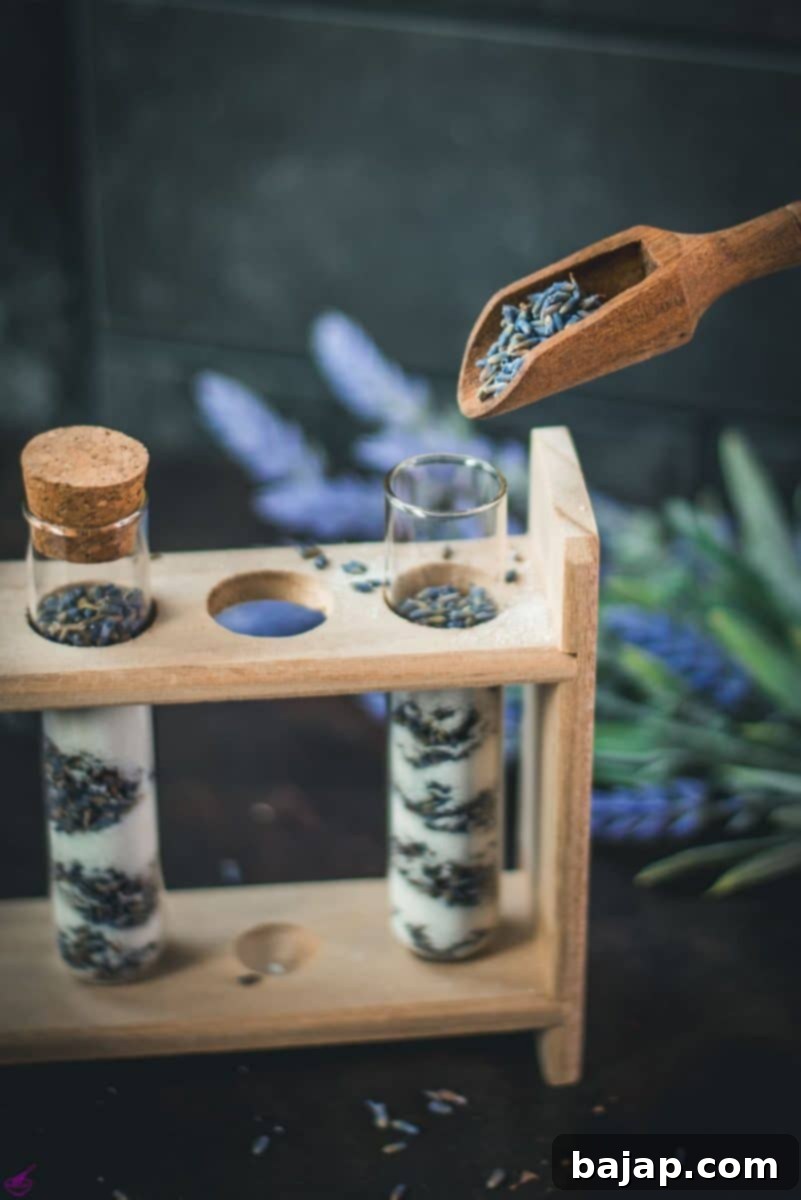
Lavender, with its signature calming purple hues and enchanting fragrance, is often hailed as the ultimate aromatic herb. Its welcoming floral scent is a natural remedy, widely recognized for its ability to alleviate stress, promote restful sleep, and generally uplift spirits. This profound appreciation for lavender is precisely why I make it a point to cultivate and incorporate this astonishing herb into my life and kitchen whenever possible!
If you share my passion for this remarkable plant, then you are absolutely going to adore this sweet and fragrant recipe for **Lavender Infused Sugar**! This simple, elegant recipe will quickly become a favorite in your culinary repertoire because it offers a multitude of benefits and irresistible charm:
- Effortless Preparation: You’ll be amazed at how quickly and easily this lavender sugar comes together. With just a couple of straightforward steps, you can create a truly gourmet ingredient that tastes and looks like it took hours.
- Baking Perfection: Homemade lavender sugar is an exceptional ingredient for baking. It imparts a subtle, sophisticated floral sweetness that beautifully complements cakes, cookies, scones, and pastries, turning ordinary baked goods into extraordinary delights.
- Aromatic Mood Booster: The sweet, delicate floral flavor and aroma of lavender are renowned for their therapeutic properties. Using this sugar in your daily routine can offer a wonderful mood boost, bringing a sense of calm and well-being with every bite or sip.
- Incredibly Versatile: Beyond baking, the uses for this delightful sugar are endless! Sprinkle it over fresh fruit, rim cocktail glasses, sweeten your coffee or tea, use it as a decorative topping, or even create unique glazes and syrups.
- The Ideal Homemade Gift: Packaged in a beautiful jar or elegant vial, this lavender sugar makes an incredibly thoughtful and charming party favor, stocking stuffer, or hostess gift. It’s a personal touch that shows you care, perfect for any occasion.
[feast_advanced_jump_to]
🥘 Simple Ingredients for Exquisite Flavor
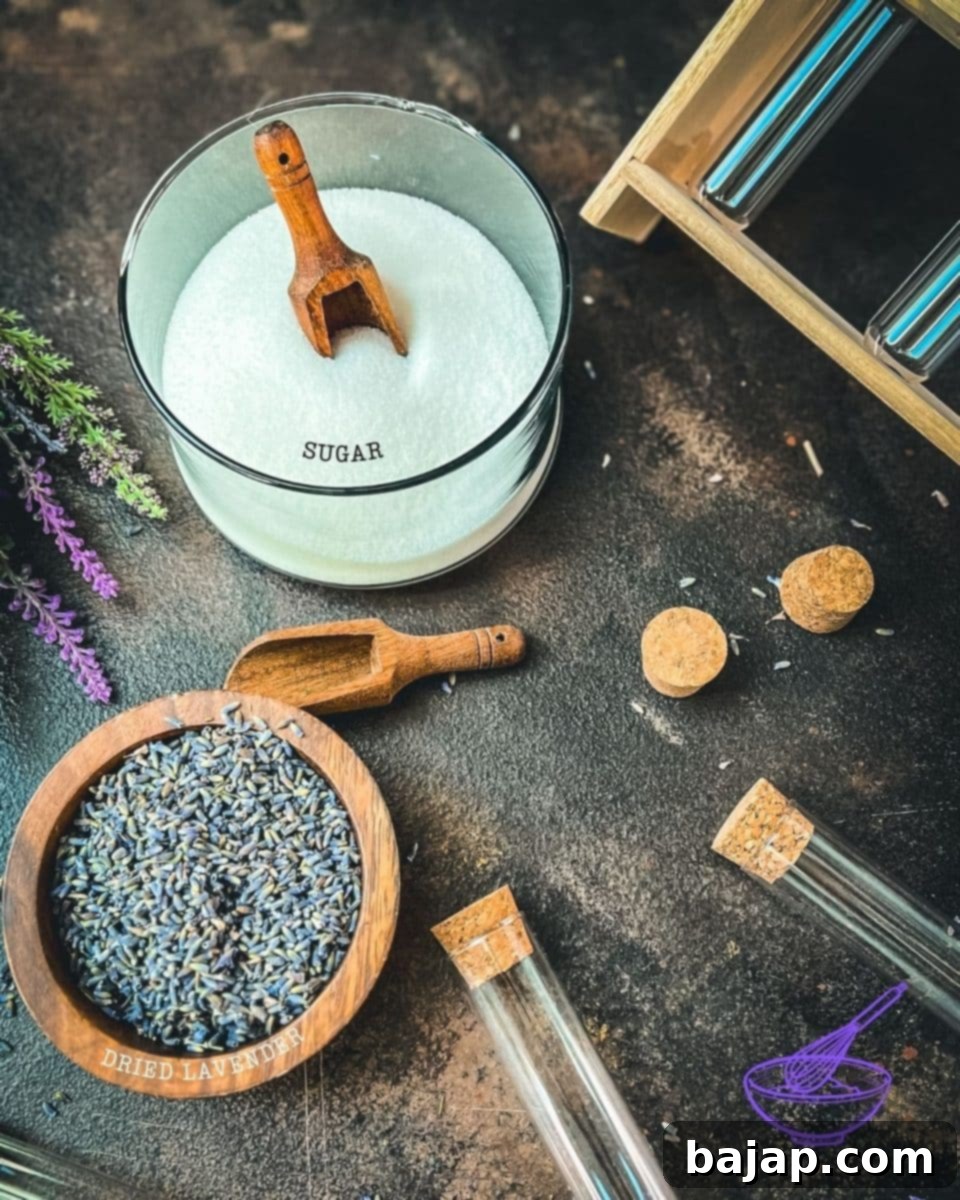
Creating this aromatic lavender sugar requires only two primary ingredients, making it an incredibly simple and accessible project. The quality of these ingredients, however, will significantly impact the final flavor and aroma of your infused sugar.
Dried Culinary Lavender: Lavender is a truly exceptional flowering herb, celebrated for its captivating fragrance and numerous beneficial properties. That’s precisely why I love to grow bundles of it every year! If you’re searching for a fantastic way to utilize your own fresh lavender harvest, look no further than this recipe. It masterfully pairs the fragrant notes of lavender with sugary sweetness, creating a truly unique and delightful flavor profile.
For this recipe, it’s crucial to use **dried culinary lavender**. This type of lavender is specifically grown and processed for consumption, ensuring it’s free from pesticides and has the ideal flavor profile – less camphor-like and more floral. You can easily purchase dried culinary lavender from specialty food stores, spice shops, or online retailers. Alternatively, if you have access to fresh lavender, you can dry your own. To dry the flowers, simply snip the stems, bundle them together, and hang them upside down in a cool, dry, and dark area. They should be completely dry and brittle within one to three weeks, depending on humidity. Any leftover dried lavender can be used to make fragrant sachets, aromatherapy blends, or even homemade lavender extract.
Granulated Sugar: This recipe truly shines when made with classic white granulated sugar. Its neutral flavor profile allows the delicate floral notes of the lavender to take center stage, creating a pure and bright infusion. Granulated sugar also has a less sticky texture compared to brown sugar, which helps prevent clumping during the infusion process and makes for a beautifully free-flowing lavender sugar. You can use regular granulated sugar, or even a finer grain “caster sugar” if you prefer a smoother texture for dusting baked goods.
See the recipe card below for precise quantities and detailed instructions.
🎁 Crafting Your Lavender Sugar: A Simple Guide
Creating your own homemade lavender sugar is a wonderfully simple process that requires minimal effort but yields impressive results. Follow these two easy steps to infuse your sugar with the enchanting aroma of lavender:
Step One: Layer the Lavender and Sugar
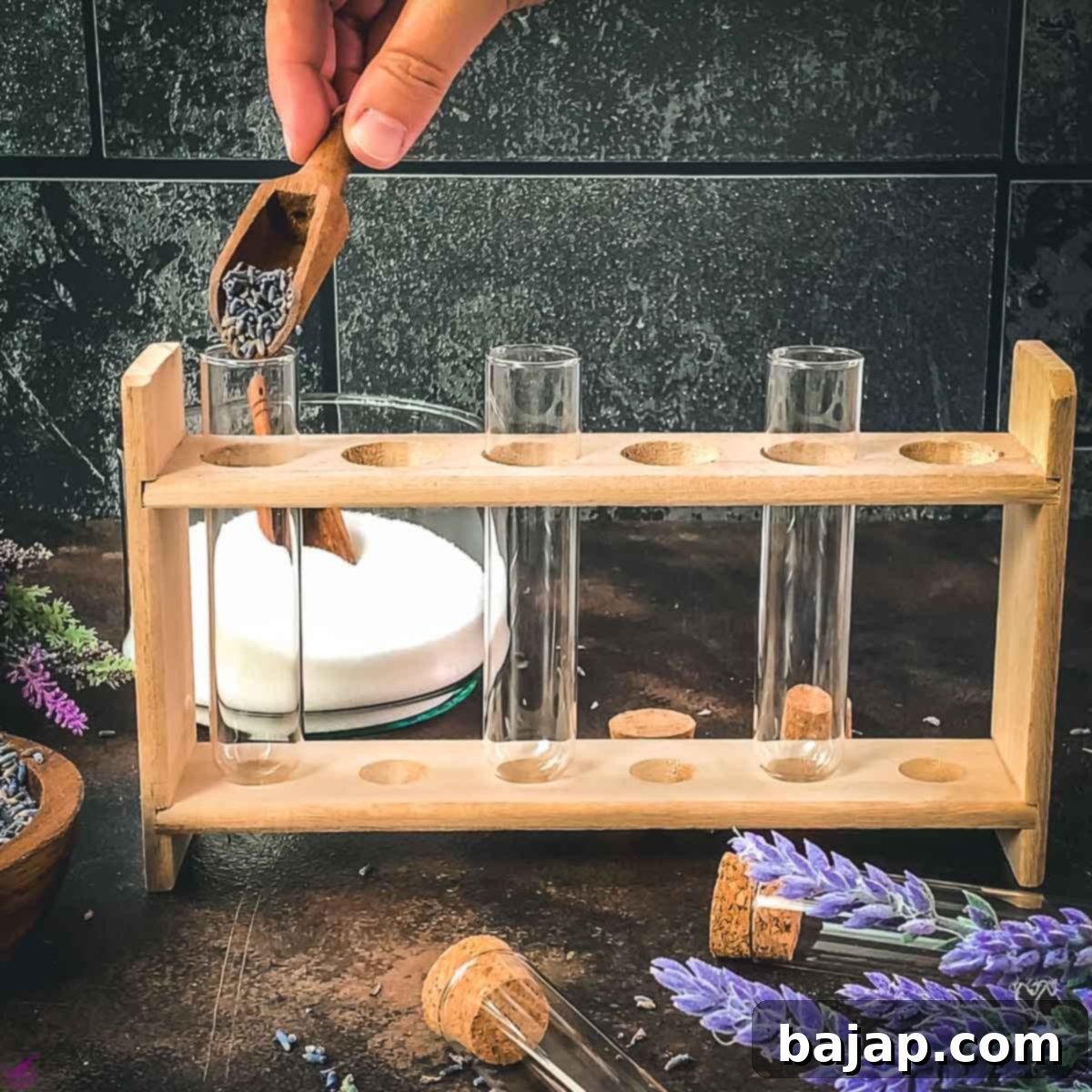
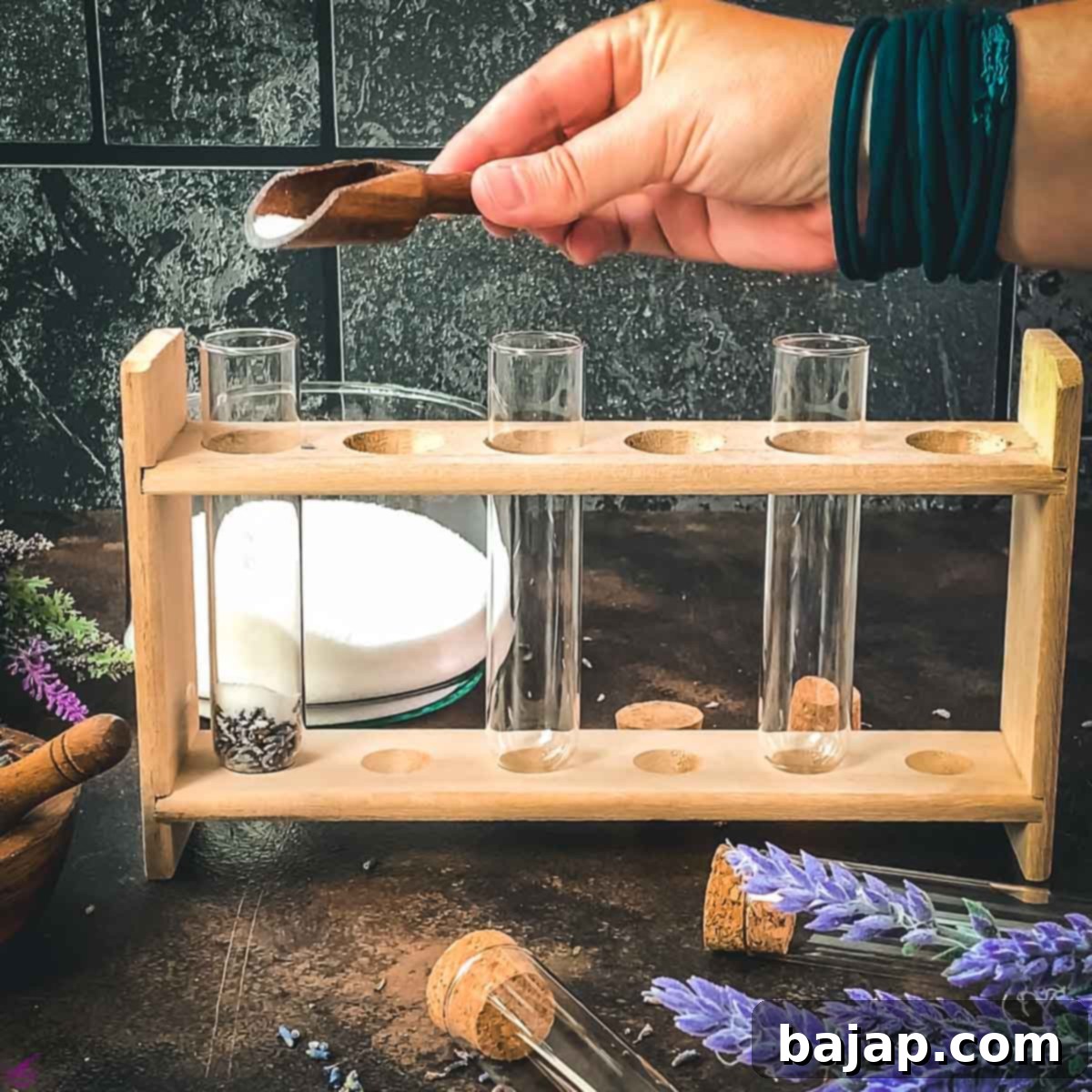
Choose a clean, dry, airtight jar or container for your lavender sugar. Start by placing a generous layer of dried culinary lavender at the bottom of the jar. Then, add a layer of granulated sugar on top of the lavender. Continue to alternate between layers of lavender and sugar until your jar is full, ending with a layer of sugar on top. The layering ensures that the lavender buds are evenly distributed throughout the sugar, maximizing the surface area for infusion and creating an aesthetically pleasing presentation, especially if you’re making this as a gift.
Step Two: Allow to Infuse for Several Weeks
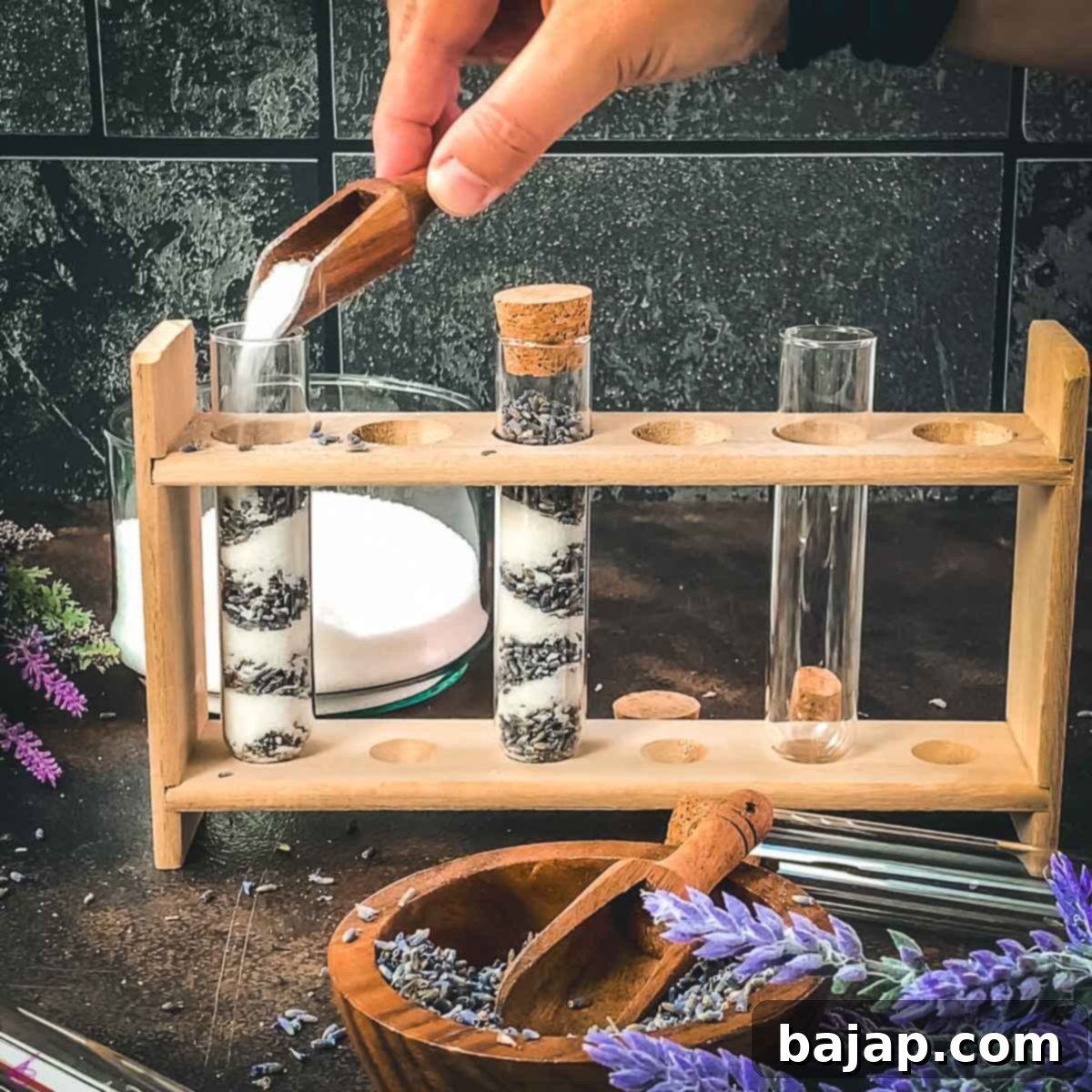
Once you’ve layered your lavender and sugar, seal the jar tightly with an airtight lid. This is a crucial step to prevent moisture from entering and to lock in the aromatic compounds released by the lavender. Place the sealed jar in a cool, dry, and dark place – a pantry or cupboard is ideal. Now comes the part that requires a little patience: allow the mixture to infuse for at least two to three weeks. During this time, the sugar will slowly absorb the delicate floral essence of the lavender, intensifying in flavor and aroma. For an even more potent infusion, you can gently shake the jar every few days to redistribute the contents.
🍓 Flavorful Substitutions for Your Lavender Sugar
While this recipe is designed to highlight the classic charm of lavender, there’s always room for personal touches and dietary considerations. Here are some simple substitutions you can make:
- Lavender Type: You have flexibility with the lavender itself. Feel free to use fresh lavender from your garden (just ensure it’s culinary grade and free of pesticides), your own carefully home-dried flowers, or conveniently store-bought dried culinary lavender. The key is to ensure it’s specifically for culinary use to guarantee the best taste and safety.
- Sweetener Alternatives: If you’re looking to reduce sugar intake or cater to specific dietary needs, the granulated sugar can be replaced with other granular sweeteners. Popular choices include granulated monk fruit or stevia. These natural sugar alternatives can provide sweetness without the calories, allowing you to enjoy the delightful lavender flavor guilt-free. Ensure the alternative sweetener has a similar granular consistency for optimal infusion and texture.
🍸 Creative Variations: Expand Your Flavored Sugar Collection
Once you’ve mastered the art of making lavender sugar, you might find yourself inspired to explore other delightful variations. Flavored sugars are incredibly versatile and can add a unique touch to countless dishes and drinks. Here are a couple of ideas to get you started:
- Fresh Floral Infusions: Don’t limit yourself to just lavender! Your garden, or a local farmer’s market, offers a bounty of other edible flowers perfect for creating exquisite infused sugars. Celebrate all the sweet flavors of nature by trading lavender for another fragrant, edible bloom. Consider roses for a romantic and classic aroma, lilacs for a sweet and heady scent, or delicate violets for a subtle, earthy sweetness. Ensure any flowers you use are specifically labeled as edible and have not been treated with pesticides. The process remains the same: layer the petals with granulated sugar and allow them to infuse.
- Smooth Vanilla Sugar: If you adore the warm, silky, and slightly woody notes of vanilla, then a homemade vanilla sugar is an absolute must-try. This simple variation creates a rich, aromatic sugar perfect for coffee, tea, baked goods, and even sprinkling over oatmeal. You can find an easy Homemade Vanilla Sugar recipe here. Typically, it involves burying whole vanilla beans in sugar for several weeks, allowing the sugar to absorb the intoxicating vanilla essence.
- Citrus Zest Sugar: For a bright and zesty twist, add dried citrus zest (lemon, orange, or lime) to your sugar. The vibrant oils from the zest will infuse the sugar with a delightful tang, perfect for baking or dusting desserts.
- Spice Infused Sugar: Experiment with warm spices like cinnamon sticks, star anise, or even a few cardamom pods. These can create wonderfully aromatic sugars for fall baking or holiday drinks.
🍽 Essential Equipment for Making Lavender Sugar
One of the beauties of this lavender sugar recipe is its simplicity, which extends to the minimal equipment required. You likely already have most of these items in your kitchen:
- Measuring Cup: A basic measuring cup will be essential for accurately portioning your granulated sugar and dried lavender, ensuring the perfect balance of flavors. Depending on the opening of your jar, a funnel might also come in handy to prevent spills and keep your workspace tidy, especially when layering.
- Airtight Jars (Mason Jar or Vials): The most crucial piece of equipment is an airtight container for infusion and storage. A standard Mason jar is ideal due to its excellent sealing capabilities, which are essential for locking in the delicate lavender aroma and keeping moisture out. However, don’t limit yourself! Small decorative bottles, jars, or even vials can be used to give your finished lavender sugar a wonderfully festive and charming look, making it perfect for gifting or display. Ensure any container you choose is clean, dry, and has a tightly sealing lid.
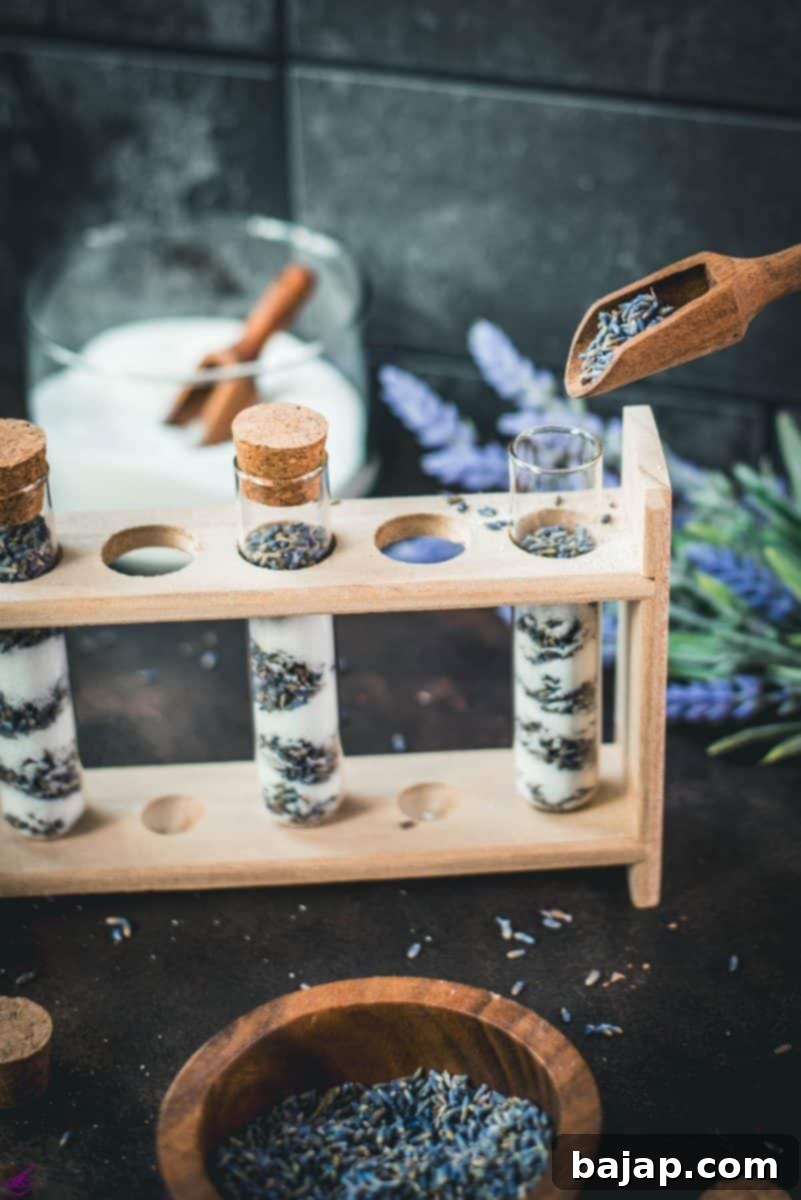
💭 Expert Tips for Perfect Lavender Sugar
Making delicious homemade lavender sugar is incredibly simple, but a few expert tips can help you achieve the best possible results and ensure your infusion is packed with flavor and aroma:
- Quick Drying Fresh Lavender: If you’re using fresh lavender from your garden and are short on time, you don’t always need to wait weeks for it to air dry. Instead, carefully rub the lavender buds off their stems. Spread them out in a single layer on a clean baking sheet or parchment paper and let them air dry for a few hours in a well-ventilated area. This quick drying method will help them release their oils more effectively into the sugar, though a longer, traditional drying process often yields a more concentrated flavor.
- Maximizing Flavor Infusion: For an even more intense lavender flavor, consider lightly bruising the dried lavender buds before layering them with sugar. You can do this by gently pressing them between your fingers or using a mortar and pestle. This helps to release more of their aromatic oils, leading to a stronger infusion.
- Storage and Longevity: Always store your lavender sugar in a cool, dark, and dry place in an airtight container. This will protect it from moisture, which can cause clumping, and light, which can degrade the delicate lavender aroma. When stored properly, homemade lavender sugar can last for several months, often up to a year, retaining its beautiful flavor and fragrance.
- Creative Uses for Leftover Lavender: Don’t let any extra dried lavender go to waste! Beyond making more sugar, you can use it to create delightful lavender frosting for cakes and cupcakes, simmer it into a simple syrup for cocktails and lemonades, or even make your own homemade lavender extract. I’m always experimenting with new ways to use this versatile herb, and I’m currently working on exciting recipes for lavender sugar cookies and a refreshing lavender lemonade – so stay tuned!
- Sifting vs. Keeping Flowers: When your lavender sugar is fully infused, you have a choice. You can leave the lavender buds mixed in for a rustic, decorative look (especially if using it as a sprinkle), or you can sift them out for a purely flavored sugar that integrates seamlessly into delicate baked goods. Both methods are perfectly fine and depend on your desired aesthetic and use.
🙋🏻 Frequently Asked Questions About Lavender Sugar
To truly bring out the best and most intense floral flavor from the lavender, the sugar should be allowed to infuse for a minimum of two to three weeks. While you might notice a subtle aroma earlier, this extended period allows the essential oils of the lavender to fully meld with the sugar crystals, creating a rich, well-rounded, and deeply aromatic product. For an even more potent flavor, some prefer to let it infuse for up to four weeks.
If you’re using fresh lavender from your garden, the traditional air-drying method takes about one to three weeks, depending on the humidity and temperature of your drying area. For a quicker alternative, if you rub the buds off and spread them in a single layer, they can dry sufficiently in about one to two hours for infusion. However, for longer storage and more potent flavor, proper slow air-drying is recommended, so plan accordingly to ensure your lavender is fully dry before infusing.
There is an abundance of wonderful uses for your finished lavender sugar! Once fully infused, this aromatic sugar can be used as a delicate dusting sugar over fresh fruit tarts, shortbread cookies, or homemade donuts. It’s a fantastic recipe mix-in for cake batters, cookie doughs, and scone recipes, imparting a unique floral sweetness. Additionally, it makes an exquisite sweetener for your morning coffee or afternoon tea, adding a soothing aroma and subtle flavor. You can also use it to rim cocktail glasses, sprinkle over oatmeal, or even incorporate it into homemade glazes and simple syrups.
It is crucial to use **culinary-grade dried lavender** for this recipe. This ensures that the lavender is safe for consumption and has a sweet, floral flavor profile without the strong camphor notes sometimes found in ornamental varieties. Avoid lavender from florists or garden centers unless explicitly stated as food-safe, as it may have been treated with pesticides.
Yes, you can! For a more uniform and potent flavor, you can lightly grind the dried lavender buds in a spice grinder or mortar and pestle before layering them with the sugar. This increases the surface area for infusion and can lead to a quicker, more intense flavor. Just be careful not to over-grind, as too fine a powder might make the sugar gritty.
More Delightful Floral & Sweet Recipes to Explore
If you’ve enjoyed the aromatic journey of making lavender sugar, you’ll be thrilled to discover other recipes that celebrate floral notes and sweet indulgences. Here are some of our favorites:
- Lavender Spritz
- Lavender Daiquiri
- Lavender Spritz with Prosecco
- Lavender Extract
- Lavender Lemon Muffins (coming soon)
- Lavender
Gin and Tonic (coming soon) - Lavender Cookies (coming soon)
- Lavender Liqueur (coming soon)
☕️ Aromatic Coffee Recipes with Lavender
Infuse your morning ritual with the calming and delightful essence of lavender. These coffee recipes offer a fragrant twist to your daily brew, perfect for a soothing start or a relaxing afternoon treat.
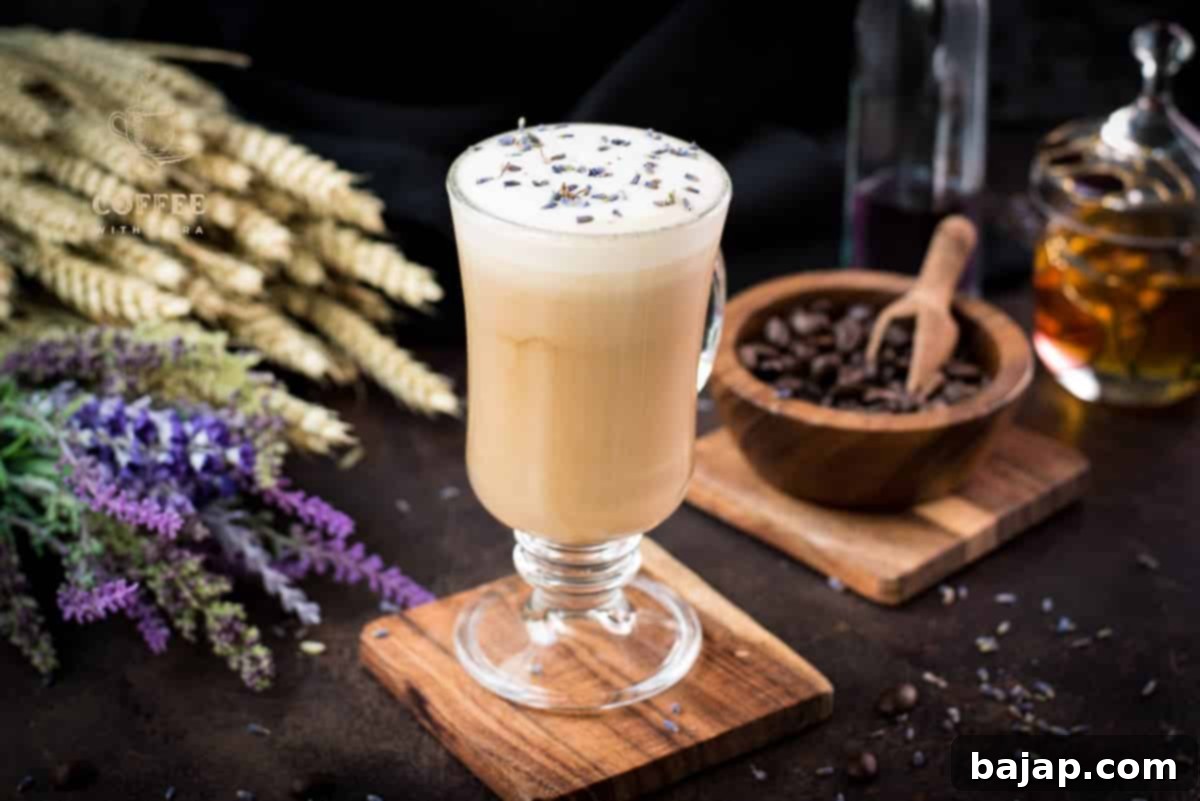
Get The Recipe
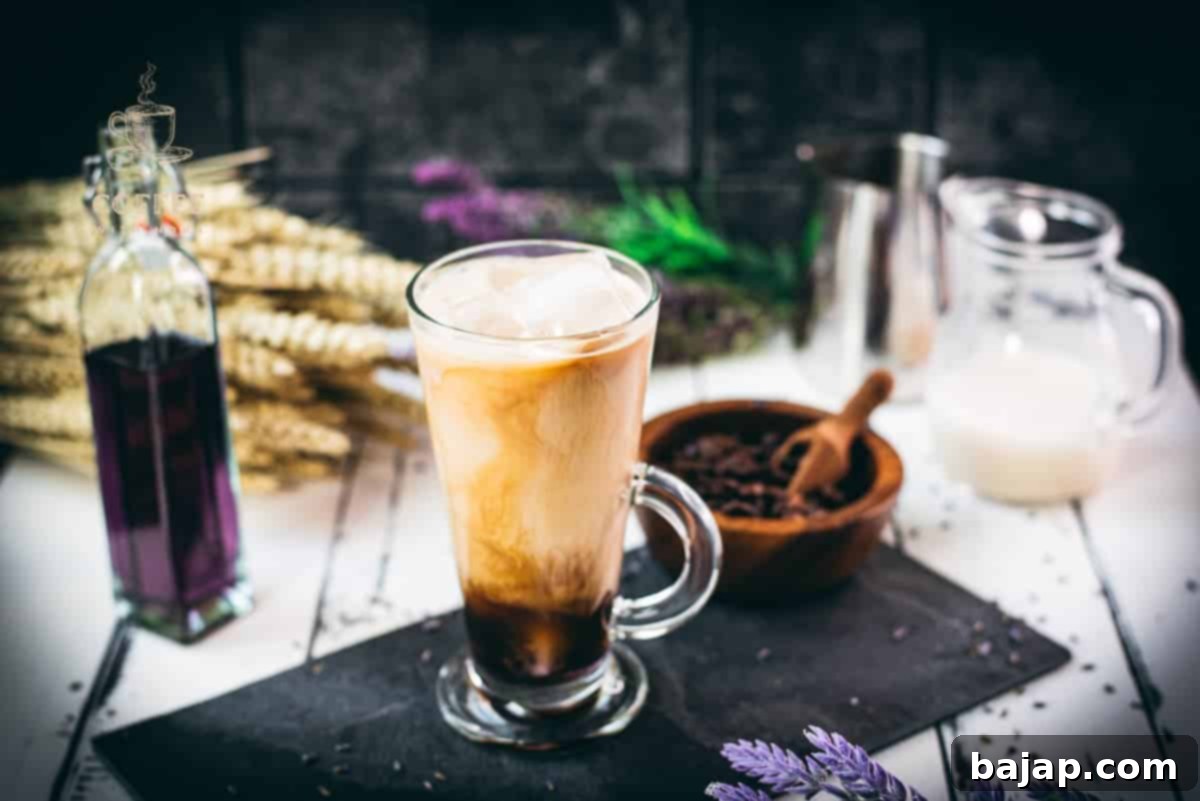
Get The Recipe
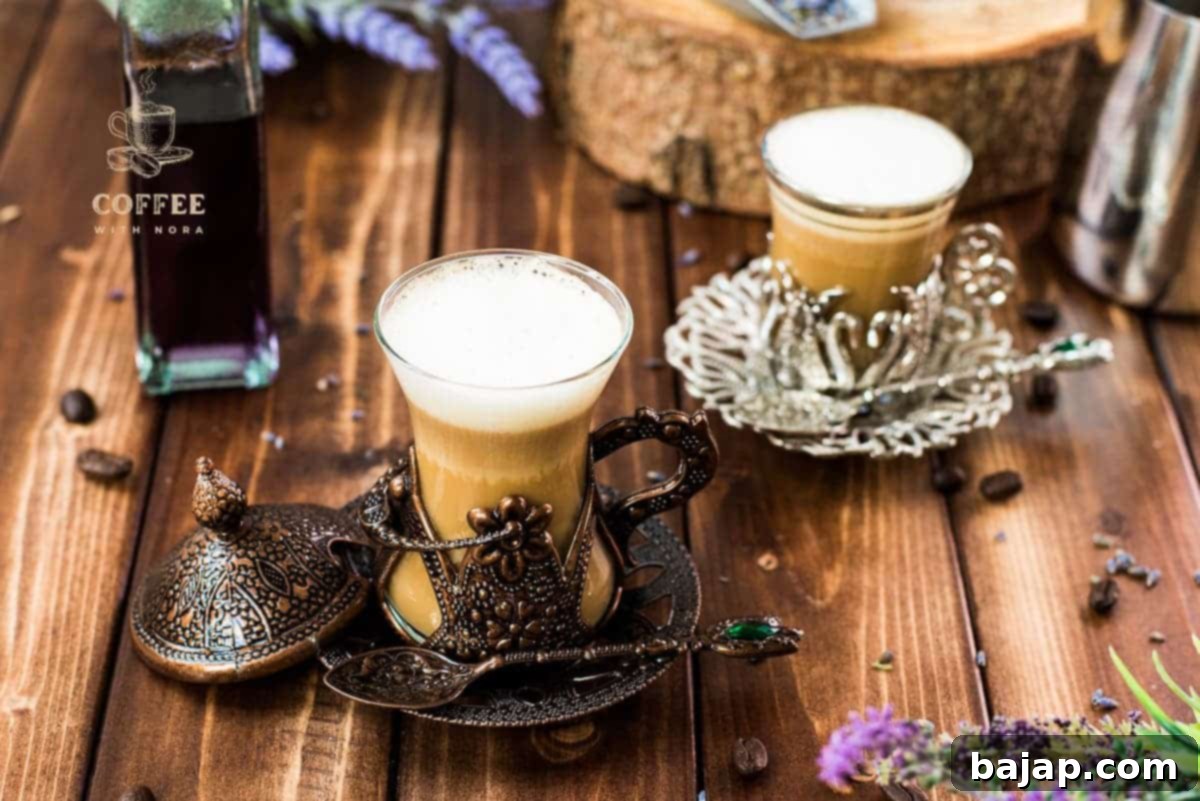
Get The Recipe
If you make this recipe, let me know how you liked it by ★★★★★ star rating it and leaving a comment below. This would be awesome! You can also sign up for our Newsletter or follow me on Pinterest or Instagram and share your creation with me. Just tag me @combinegoodflavors and hashtag #combinegoodflavors, so I don’t miss it.
📖 Recipe: Homemade Lavender Sugar
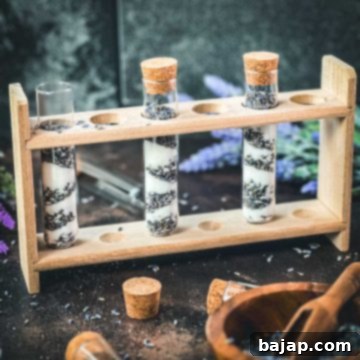
Homemade Lavender Sugar
Nora
Save RecipeSaved!
Pin Recipe
Equipment
-
Measuring cup
-
Mason Jar or small jars/bottles if you wanna give it as a gift
Ingredients
- 1.7 oz Dried culinary lavender
- 1.7 oz Granulated sugar
Instructions
-
If using fresh lavender, gently rub the lavender buds off their stems and spread them on a clean surface to dry for a few hours until brittle. (You can also use already dried culinary lavender flowers if you do not have fresh lavender available, skipping this initial drying step).
-
Carefully layer your 1.7 oz Dried culinary lavender and 1.7 oz Granulated sugar in clean, dry jars. Start with a layer of lavender, then sugar, and alternate until the jar is full, ending with sugar. Seal the jars well with an airtight lid.1.7 oz Dried culinary lavender, 1.7 oz Granulated sugar
-
Store the sealed jars in a cool, dark place. Allow the lavender sugar to infuse for at least two to three weeks. This crucial infusion period allows the sugar to fully absorb the beautiful, delicate aroma of the lavender, resulting in a rich and fragrant product. Gently shake the jar every few days to redistribute the contents and enhance the infusion.
Notes
Usage in Baking: Lavender sugar is incredibly versatile for preparing cakes, cookies, and other desserts. You can choose to sift out the lavender flowers for a smooth sugar or leave them in for added visual appeal and a more rustic texture within your dough.
Perfect for Gifting: Elegantly packaged lavender sugar makes an exquisite and thoughtful small gift for guests, friends, and family. It’s a charming way to share your homemade culinary creations.
Nutrition values are estimates only, using online calculators. Please verify using your own data.

🤎 You Might Also Like These Recipes
If you enjoyed crafting and using homemade lavender sugar, explore these other delightful recipes to further enhance your culinary skills and add unique flavors to your repertoire.
- Peach Purée for Bellini (and More!)
- Best Cookie Scoop
- Dreamy Lavender Buttercream {Two Ways}
- Homemade White Chocolate Pistachio Ganache
⛑️ Important Food Safety Guidelines
Ensuring food safety is paramount when preparing any recipe, even simple ones like infused sugars. Following these guidelines helps maintain a safe and healthy kitchen environment:
- Cook any food containing raw ingredients to a minimum internal temperature of 165 °F (74 °C) to eliminate harmful bacteria.
- Always use separate utensils for raw and cooked food to prevent cross-contamination. Never let utensils that have touched raw meat come into contact with cooked food without thorough washing.
- Wash your hands thoroughly with soap and warm water for at least 20 seconds after handling raw meat or any potentially hazardous ingredients.
- Avoid leaving food sitting out at room temperature for extended periods (generally no more than two hours), as this can promote bacterial growth.
- Never leave cooking food unattended on the stovetop or in the oven; a moment’s distraction can lead to overcooking or fire hazards.
- When frying or sautéing, use cooking oils with a high smoke point to prevent the formation of harmful compounds and off-flavors.
- Always ensure good ventilation in your kitchen, especially when using a gas stove, to prevent the buildup of fumes and improve air quality.
For further comprehensive information and best practices, always check reliable sources such as Safe Food Handling – FDA.
